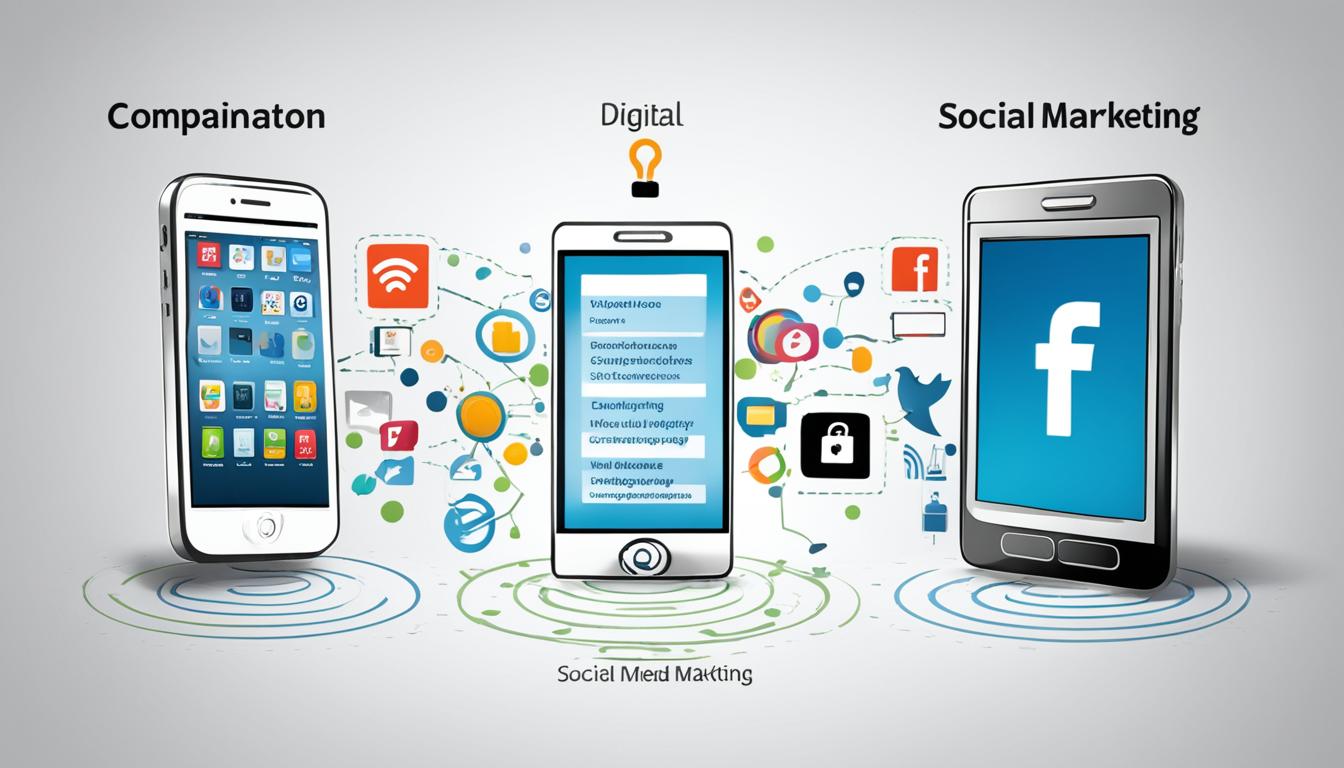Relationship marketing and transactional marketing are two distinct strategies used by businesses to market their goods and services. Relationship marketing focuses on building long-term relationships with customers and fostering customer loyalty, while transactional marketing aims to make quick sales without forming lasting customer connections. Understanding the differences between these two approaches is crucial for businesses looking to develop effective marketing strategies and drive business growth.
Relationship marketing strives to create personalized interactions with customers, establishing emotional connections that lead to long-term relationships. It prioritizes customer loyalty and repeat business, recognizing the value of each customer’s lifetime value. This approach involves tracking customer activities, preferences, and feedback through CRM systems, enabling businesses to tailor their messaging and advertisements to individual customer profiles. By placing a strong emphasis on customer service and satisfaction, relationship marketing aims to improve customer retention rates and foster brand loyalty.
Transactional marketing, on the other hand, focuses on one-time purchases and immediate sales. The main objective is to increase the efficiency and volume of point-of-sale transactions. This approach relies on traditional marketing elements such as product, pricing, placement, and promotion to entice customers into making quick purchases. While transactional marketing may not prioritize long-term customer relationships, it can offer benefits such as low costs and high inventory turnover for businesses.
By understanding the distinctions between relationship marketing and transactional marketing, businesses can make informed decisions about which strategy aligns best with their goals and target audience. Implementing a combination of both strategies may be the key to achieving customer loyalty, long-term relationships, repeat business, and brand loyalty.
Key Takeaways:
- Relationship marketing focuses on building long-term relationships and fostering customer loyalty.
- Transactional marketing prioritizes one-time purchases and quick sales.
- Relationship marketing involves personalized interactions and emotional connections.
- Transactional marketing aims for efficiency and high volume of point-of-sale transactions.
- Customer lifetime value and brand loyalty are important aspects of relationship marketing.
What is Transactional Marketing?
Transactional marketing is a marketing strategy that focuses on increasing the efficiency and volume of point-of-sale transactions. Unlike other marketing approaches, transactional marketing prioritizes making a sale rather than building a long-term relationship with the customer. This strategy involves minimal customer interaction beyond the purchase stage.
Transactional marketing follows the traditional elements of marketing, including product, pricing, placement, and promotion. Businesses employing this strategy aim to offer high-quality products at attractive prices to entice customers to make purchases. Promotions and discounts are often used to create a sense of urgency and persuade customers to take immediate action.
| Elements of Transactional Marketing | Description |
|---|---|
| Product | The focus is on delivering high-quality products that meet customer needs and preferences. |
| Pricing | Attractive pricing strategies such as discounts and promotions are used to drive sales. |
| Placement | Products are strategically placed in locations where they are easily accessible to customers. |
| Promotion | Marketing efforts are aimed at creating awareness and stimulating purchase decisions through various promotional tactics. |
Transactional marketing is a valuable strategy for businesses looking to generate immediate sales and increase their revenue. However, it is important to note that transactional marketing alone may not foster long-term customer loyalty or repeat business. To achieve sustained growth, businesses often combine transactional marketing with other approaches, such as relationship marketing. (Based on the factual data from “First source:”)
Benefits of Transactional Marketing
Transactional marketing offers several benefits for businesses that employ this strategy. First, it tends to be a cost-effective approach, as campaigns are often inexpensive to implement. By focusing on quick sales and point-of-sale transactions, businesses can minimize their marketing expenses while still driving revenue. This is particularly advantageous for startups and small businesses with limited marketing budgets.
Second, transactional marketing can result in high inventory turnover. With this approach, businesses prioritize making swift sales, which allows them to quickly replenish their inventory with in-demand items. High inventory turnover not only ensures that shelves are stocked with popular products but also generates more revenue through increased sales volume.
To better illustrate the benefits of transactional marketing, take a look at the following table:
| Benefits of Transactional Marketing | Explanation |
|---|---|
| Low cost | Transactional marketing campaigns are often inexpensive to execute, making it a cost-effective strategy for businesses. |
| High inventory turnover | By focusing on quick sales, businesses can rapidly replenish their inventory with in-demand items, increasing overall revenue. |
The table provides a clear overview of the benefits of transactional marketing, highlighting its low cost and high inventory turnover advantages. These benefits can contribute to reducing costs associated with managing large inventories and improving overall profitability for businesses.
What is Relationship Marketing?
Relationship marketing is a customer-centric marketing strategy that focuses on building strong, long-term relationships between brands and customers. This approach recognizes the value of customer relationships and aims to foster customer loyalty and repeat sales. By prioritizing personalized interactions, tailored messaging, and exceptional customer service, relationship marketing creates a positive customer experience that leads to increased customer satisfaction and retention.
Key elements of relationship marketing include:
- Building customer relationships: Relationship marketing emphasizes the importance of developing meaningful connections with customers. It goes beyond one-time transactions to establish ongoing and mutually beneficial relationships.
- Repeat sales and customer loyalty: By investing in customer relationships, businesses can encourage repeat sales and foster customer loyalty. Satisfied and loyal customers are more likely to choose a brand over its competitors, leading to long-term revenue growth.
- Personalized messaging: Relationship marketing tailors messages and advertisements based on individual customer profiles. This personalized approach helps businesses resonate with their target audience and build stronger connections.
- Exceptional customer service: Customer service plays a vital role in relationship marketing. By providing excellent service, addressing customer needs promptly, and resolving issues effectively, businesses can improve customer satisfaction and loyalty.
Relationship Marketing vs. Transactional Marketing
| Criteria | Relationship Marketing | Transactional Marketing |
|---|---|---|
| Customer Focus | Strong emphasis on building customer relationships | Primary focus on making one-time sales |
| Sales Approach | Encourages repeat sales through personalized interactions and tailored messaging | Focuses on maximizing efficiency and volume of point-of-sale transactions |
| Customer Loyalty | Fosters customer loyalty through exceptional customer service and personalized experiences | Relies on product quality, pricing, and promotions to attract customers |
| Customer Service | Places a strong emphasis on providing exceptional customer service and satisfying customer needs | Minimal customer interaction beyond the point of sale |
Benefits of Relationship Marketing
Relationship marketing, as opposed to transactional marketing, offers several advantages for businesses aiming for long-term success. By prioritizing strong customer relationships, businesses can reap the following benefits:
- High ROI: Relationship marketing can deliver a high return on investment (ROI) by fostering repeat purchases from loyal customers. The cost-effectiveness of retaining existing customers and encouraging them to make repeat purchases is often superior to constantly acquiring new customers.
- Increased Customer Feedback: Through relationship marketing, businesses can foster customer engagement and obtain valuable insights through feedback. This feedback enables businesses to improve their products and services based on customer preferences and needs, ultimately leading to higher customer satisfaction and loyalty.
- Long-Term Sales: Building strong customer relationships results in long-term sales, as customers tend to continue purchasing from brands they trust. By consistently providing personalized experiences, businesses can secure customer loyalty and drive sales over extended periods.
Adding a visual element to this article, here’s an image illustrating the benefits of relationship marketing:
Next, let’s dive into some real-life examples showcasing the effectiveness of transactional marketing:
Transactional Marketing Example
In the world of marketing, transactional marketing provides businesses with a valuable strategy to drive quick sales and encourage immediate customer action. It focuses on short-term transactions rather than long-term relationships. To better illustrate how transactional marketing works in practice, let’s take a look at a couple of examples:
Example 1: Buy One, Get One (BOGO) Offers
One popular transactional marketing example is the “buy one, get one” (BOGO) offer. Imagine a shopping channel on TV promoting a new product by enticing customers with a compelling BOGO offer. The advertisement provides a phone number or website where customers can place an order immediately to take advantage of the offer. The limited-time nature of this promotion encourages quick decision-making and prompts customers to make a purchase in the moment.
Example 2: Promotional Displays in Convenience Stores
Another example of transactional marketing can be found in convenience stores. Picture a scenario where a convenience store is selling a particular product. To drive sales, the store strategically places a promotional display next to the product. This display showcases a different brand at a lower price, capturing the attention of customers and influencing their purchase decisions.
These transactional marketing examples highlight the emphasis on quick sales and limited customer interaction. By leveraging compelling offers like BOGO deals and utilizing promotional displays, businesses can effectively capture customer attention and drive immediate purchases.
Relationship Marketing Example
Relationship marketing is all about nurturing strong connections with customers and fostering loyalty. Here are some examples of relationship marketing strategies that businesses employ to promote customer satisfaction and drive repeat sales:
- Customer appreciation posts on social media: Businesses often express their gratitude towards customers by showcasing their stories, highlighting their loyalty, and featuring their positive experiences with the brand.
- Loyalty programs: Offering exclusive benefits, rewards, and discounts to long-term or repeat customers can incentivize continued engagement and purchases.
- Customer surveys: Gathering feedback through customer surveys helps businesses understand their customers’ preferences, needs, and satisfaction levels. This valuable data can be used to tailor products, services, and marketing strategies to better meet customer expectations.
- Repeat customer bonuses: Providing special perks, incentives, or discounts for customers who make repeat purchases encourages loyalty and strengthens the bond between the brand and its customers.
These relationship marketing examples showcase how businesses go the extra mile to foster meaningful connections with their customers, resulting in increased satisfaction, loyalty, and long-term sales.

**Table:** Examples of Relationship Marketing Strategies
| Relationship Marketing Strategy | Description |
|———————————|———————————————————————————————-|
| Customer appreciation posts | Featuring customer stories, loyalty highlights, and positive interactions on social media |
| Loyalty programs | Exclusive benefits, rewards, and discounts for long-term or repeat customers |
| Customer surveys | Gathering feedback to understand customer preferences, needs, and satisfaction levels |
| Repeat customer bonuses | Special perks, incentives, or discounts for customers making repeat purchases |
Transactional Marketing vs Relationship Marketing
Transactional marketing and relationship marketing are two distinct approaches to marketing that businesses can use to achieve different goals. Let’s explore the differences between these two strategies.
Transactional Marketing
Transactional marketing is focused on making one-time sales and increasing the efficiency of point-of-sale transactions. It relies on mass marketing techniques and promotional strategies to attract customers and drive immediate purchases. Minimal customer interaction is involved beyond the sale itself. The primary objective of transactional marketing is to maximize short-term sales volume.
Relationship Marketing
On the other hand, relationship marketing aims to build long-term relationships and foster customer loyalty. It prioritizes personalized marketing and frequent communication with customers. Relationship marketing involves creating emotional connections, providing exceptional customer service, and implementing loyalty programs to encourage repeat business. The main goal of relationship marketing is to maximize long-term customer value and promote brand loyalty.
Now, let’s compare the key differences between transactional marketing and relationship marketing:
| Transactional Marketing | Relationship Marketing |
|---|---|
| Mass marketing and promotion | Personalized marketing |
| Short-term communications | Long-term benefits |
| Minimal customer interaction beyond the sale | Frequent customer communication and engagement |
| Promotional strategies | Loyalty programs |
While transactional marketing focuses on quick sales and low customer interaction, relationship marketing aims to build lasting relationships and maximize long-term customer value. Businesses need to consider their specific goals, target audience, and resources when determining which approach is most suitable for their marketing strategies.
By understanding the differences and benefits of transactional marketing and relationship marketing, businesses can make informed decisions to drive their marketing efforts and achieve their desired outcomes.
Choosing the Right Marketing Strategy for Your Business
When it comes to selecting a marketing strategy for your business, there are important factors to consider. Customer preferences, business goals, customer acquisition costs, and customer retention all play a role in choosing the right approach. It’s essential to align your marketing strategy with your target audience and long-term objectives in order to drive success.
Understanding customer preferences is key to developing an effective marketing strategy. Analyze market research, customer surveys, and feedback to gain insights into what your target audience wants and expects from your brand. By tailoring your approach to meet their needs, you can create more impactful marketing campaigns that resonate with your customers.
Business goals also influence the choice of marketing strategy. Whether your focus is on increasing sales, expanding market share, or building brand loyalty, your marketing approach should align with these objectives. For example, if your goal is to build long-term customer relationships and maximize customer lifetime value, relationship marketing may be the right fit. On the other hand, if you’re looking to drive quick sales and increase transaction volume, transactional marketing could be more suitable.
Consider the costs of customer acquisition versus retention. While acquiring new customers is important for business growth, it can be more cost-effective to retain existing customers. Relationship marketing, with its emphasis on fostering customer loyalty and repeat business, may help reduce customer acquisition costs over time. On the other hand, transactional marketing can be more focused on acquiring new customers through short-term promotional strategies.
It’s also important to weigh the benefits and drawbacks of each marketing strategy. Transactional marketing may offer advantages such as low cost and high inventory turnover, while relationship marketing can lead to a higher return on investment, increased customer feedback, and long-term sales. Carefully consider the pros and cons of each approach to determine which best suits your business needs.
Choosing the Right Marketing Strategy
| Factors to Consider | Transactional Marketing | Relationship Marketing |
|---|---|---|
| Customer Preferences | Focus on immediate sales | Personalized interactions, customer service |
| Business Goals | Quick sales, transaction volume | Customer loyalty, repeat business |
| Customer Acquisition Costs | Short-term promotional strategies | Fostering long-term customer relationships |
| Customer Retention | Minimal customer interaction | Consistent communication, engagement |
Making an informed decision about the right marketing strategy for your business involves analyzing these factors and comparing them against your unique circumstances. Take the time to evaluate your audience, goals, costs, and desired outcomes to determine the most suitable approach. Remember, it’s possible to combine elements of both transactional and relationship marketing to create a comprehensive strategy that drives customer loyalty and business growth.
Conclusion
In conclusion, the comparison between relationship marketing and transactional marketing reveals distinct strategies employed by businesses to market their goods and services. Transactional marketing focuses on making one-time sales without forming lasting customer connections, while relationship marketing aims to build strong customer relationships and foster repeat business. Both strategies have their unique benefits.
When deciding which approach to implement, businesses should consider factors such as customer preferences, business goals, and the cost-effectiveness of customer acquisition and retention. Transactional marketing emphasizes quick sales and minimal customer interaction, while relationship marketing prioritizes personalized interactions and long-term customer relationships.
To drive customer loyalty and business growth, businesses may find it most effective to combine both strategies. By incorporating personalized interactions and fostering emotional connections with customers, businesses can encourage repeat business and build brand loyalty. Ultimately, the goal is to maximize customer lifetime value and create long-term customer relationships that result in sustained success.
FAQ
What is the difference between relationship marketing and transactional marketing?
Relationship marketing focuses on building long-term relationships with customers and fostering customer loyalty, while transactional marketing aims to make quick sales without forming lasting customer connections.
What is transactional marketing?
Transactional marketing is a strategy that prioritizes increasing the efficiency and volume of point-of-sale transactions. The main focus is on making a sale, rather than building a relationship with the customer.
What are the benefits of transactional marketing?
Transactional marketing tends to be cost-effective, as campaigns are often inexpensive to implement. It can also result in high inventory turnover, allowing businesses to quickly replenish shelves and generate more revenue.
What is relationship marketing?
Relationship marketing focuses on building strong, long-term relationships between brands and customers. The goal is to encourage repeat sales and foster customer loyalty through personalized interactions and customer service.
What are the benefits of relationship marketing?
Relationship marketing can lead to a high return on investment (ROI) due to the increased likelihood of repeat purchases from loyal customers. It also promotes customer feedback and engagement, which provides valuable insights for improving products and services.
Can you give an example of transactional marketing?
An example of transactional marketing is a shopping channel on TV that advertises a “buy one, get one” (BOGO) offer for a new product. This encourages immediate purchases without forming long-term relationships.
Can you give an example of relationship marketing?
Examples of relationship marketing include businesses that thank customers through social media posts, offer discounts to long-term or repeat customers, conduct customer feedback surveys, and launch customer loyalty programs.
What are the main differences between transactional marketing and relationship marketing?
Transactional marketing focuses on one-time sales and has minimal customer interaction beyond the sale, while relationship marketing prioritizes building long-term relationships with frequent communication and engagement.
How do I choose the right marketing strategy for my business?
The choice between transactional marketing and relationship marketing depends on various factors including customer preferences, business goals, and the cost of customer acquisition versus retention. Analyzing customer preferences and weighing the costs and benefits of each strategy can help businesses make an informed decision.




